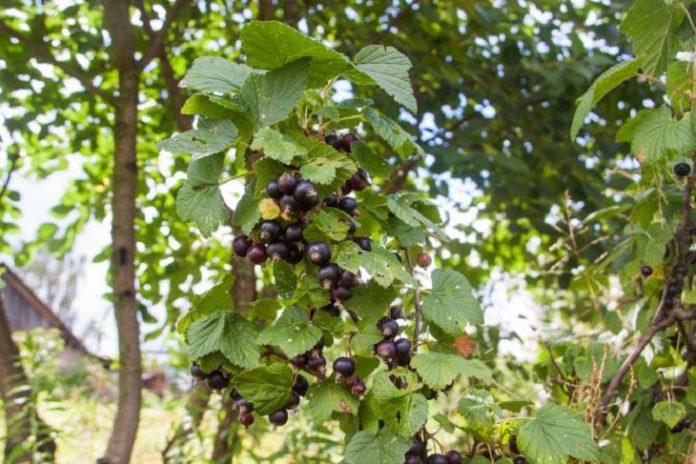Gardeners often face the problem of currant leaf curling. This phenomenon can seriously affect the health of the plant and the quality of the crop..
Understanding the reasons for this condition of the leaves will help you take timely measures and keep the currant bush healthy and fruitful..
Aphids are the main pest
The most common reason for the curling of currant leaf tips is an aphid infestation. These small insects feed on the sap of the plant, causing deformation of young leaves.
Aphids reproduce quickly, forming colonies on the underside of leaves and young shoots. As a result of their activity, the leaves not only curl, but can also acquire a yellowish tint, and the shoots become curved.
Aphid control requires an integrated approach. You can use both chemical plant protection products and folk methods.
Spraying the bushes with a soap solution or tobacco infusion is effective. For prevention, it is recommended to attract natural enemies of aphids to the garden – ladybugs and lacewings.
Fungal diseases
Leaves curling can be a symptom of fungal diseases such as anthracnose or septoria.
With these diseases, spots appear on the leaves, and then they become deformed and curl. Fungal infections develop especially actively in humid weather.
Gardeners often face the problem of currant leaf curling. This phenomenon can seriously affect the health of the plant and the quality of the crop..
Understanding the reasons for this condition of the leaves will help you take timely measures and keep the currant bush healthy and fruitful..
Aphids are the main pest
The most common reason for the curling of currant leaf tips is an aphid infestation. These small insects feed on the sap of the plant, causing deformation of young leaves.
Aphids reproduce quickly, forming colonies on the underside of leaves and young shoots. As a result of their activity, the leaves not only curl, but can also acquire a yellowish tint, and the shoots become curved.
Aphid control requires an integrated approach. You can use both chemical plant protection products and folk methods.
Spraying the bushes with a soap solution or tobacco infusion is effective. For prevention, it is recommended to attract natural enemies of aphids to the garden – ladybugs and lacewings.
Fungal diseases
Leaves curling can be a symptom of fungal diseases such as anthracnose or septoria.
With these diseases, spots appear on the leaves, and then they become deformed and curl. Fungal infections develop especially actively in humid weather.
Gardeners often face the problem of currant leaf curling. This phenomenon can seriously affect the health of the plant and the quality of the crop..
Understanding the reasons for this condition of the leaves will help you take timely measures and keep the currant bush healthy and fruitful..
Aphids are the main pest
The most common reason for the curling of currant leaf tips is an aphid infestation. These small insects feed on the sap of the plant, causing deformation of young leaves.
Aphids reproduce quickly, forming colonies on the underside of leaves and young shoots. As a result of their activity, the leaves not only curl, but can also acquire a yellowish tint, and the shoots become curved.
Aphid control requires an integrated approach. You can use both chemical plant protection products and folk methods.
Spraying the bushes with a soap solution or tobacco infusion is effective. For prevention, it is recommended to attract natural enemies of aphids to the garden – ladybugs and lacewings.
Fungal diseases
Leaves curling can be a symptom of fungal diseases such as anthracnose or septoria.
These diseases cause spots to appear on the leaves, which then become deformed and curl
Gardeners often face the problem of currant leaf curling. This phenomenon can seriously affect the health of the plant and the quality of the crop..
Understanding the reasons for this condition of the leaves will help you take timely measures and keep the currant bush healthy and fruitful..
Aphids are the main pest
The most common reason for the curling of currant leaf tips is an aphid infestation. These small insects feed on the sap of the plant, causing deformation of young leaves.
Aphids reproduce quickly, forming colonies on the underside of leaves and young shoots. As a result of their activity, the leaves not only curl, but can also acquire a yellowish tint, and the shoots become curved.
Aphid control requires an integrated approach. You can use both chemical plant protection products and folk methods
Gardeners often face the problem of currant leaf curling. This phenomenon can seriously affect the health of the plant and the quality of the crop..
Understanding the reasons for this condition of the leaves will help you take timely measures and keep the currant bush healthy and fruitful..
Aphids are the main pest
The most common reason for the curling of currant leaf tips is an aphid infestation. These small insects feed on the sap of the plant, causing deformation of young leaves.
Aphids reproduce quickly, forming colonies on the underside of leaves and young shoots
Gardeners often face the problem of currant leaf curling. This phenomenon can seriously affect the health of the plant and the quality of the crop..
Understanding the reasons for this condition of the leaves will help you take timely measures and keep the currant bush healthy and fruitful..
Aphids are the main pest
The most common causecurling of the tops of currant leaves is an invasion of aphids. These small insects feed on the sap of the plant, causing deformation of young leaves.
Aphids reproduce quickly, forming colonies on the underside of leaves and young shoots. As a result of their activity, the leaves not only curl, but can also acquire a yellowish tint, and the shoots become curved.
Fighting aphids requires an integrated approach. You can use both chemical plant protection products and folk methods.
Spraying the bushes with a soap solution or tobacco infusion is effective. For prevention, it is recommended to attract natural enemies of aphids to the garden – ladybugs and lacewings.
Fungal diseases
Leaf curling can be a symptom of fungal diseases such as anthracnose or septoria.
With these diseases, spots appear on the leaves, and then they become deformed and curl. Fungal infections develop especially actively in wet weather.
To combat fungal diseases, it is necessary to carry out preventive treatments with fungicides in early spring and after harvesting.
It is also important to follow agricultural practices: do not thicken plantings, remove weeds in a timely manner and carry out sanitary pruning of bushes.
Lack of nutrients
Sometimes the reason for curling leaves can be a deficiency of important plant nutrients, especially magnesium and boron.
With a lack of these microelements, the process of photosynthesis is disrupted,which leads to deformation of the leaf blade.
To eliminate the deficiency, it is necessary to carry out foliar feeding with complex fertilizers containing microelements.
It is also important to monitor the acidity of the soil, since if the pH is too high or too low, the absorption of nutrients by the plant roots is disrupted.
Adverse weather conditions
Sharp temperature changes, especially in spring, can cause curling of young currant leaves.
This is a protective reaction of the plant to stress. Usually, when weather conditions stabilize, the leaves straighten out on their own.
To minimize the impact of weather factors, it is recommended to choose places protected from the wind for planting currants and, if necessary, install temporary shelters during frosts.
Viral infections
In some cases, leaf curling can be a symptom of a viral disease. Viruses can be transmitted through pruning tools or through insect carriers.
Unfortunately, viral diseases are incurable, and infected plants are recommended to be removed to prevent the spread of infection.
To prevent viral diseases, it is important to use healthy planting material, disinfect garden tools and control insect carriers.
Understanding the reasons for the curling of currant leaves allows gardeners to take timely measures to protect plants.
Regular inspection of bushes,proper care and preventive measures will help maintain the health of currants and ensure a good harvest of aromatic and healthy berries.


